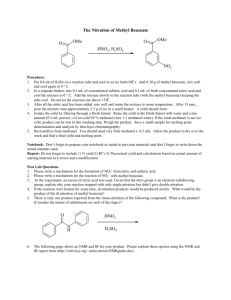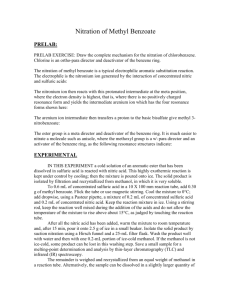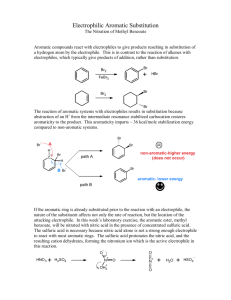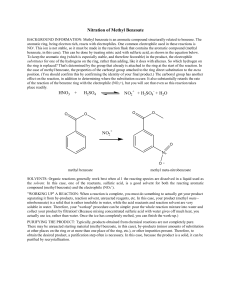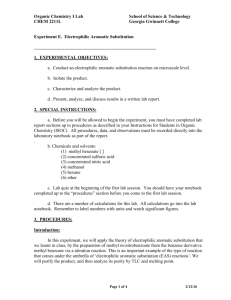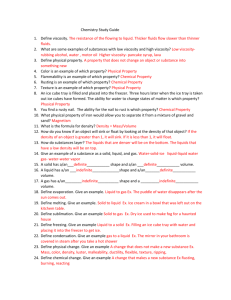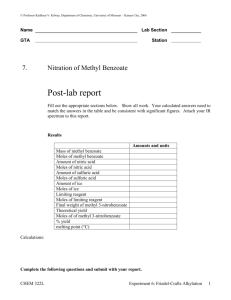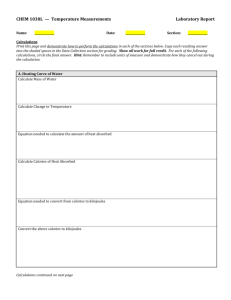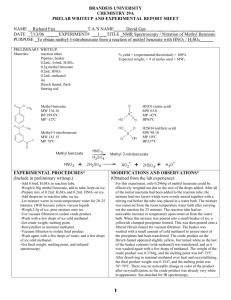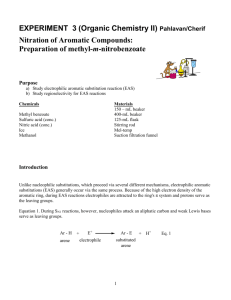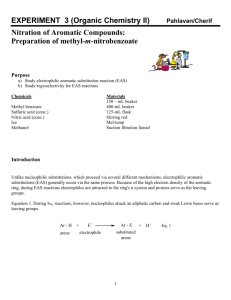OCR Document
advertisement
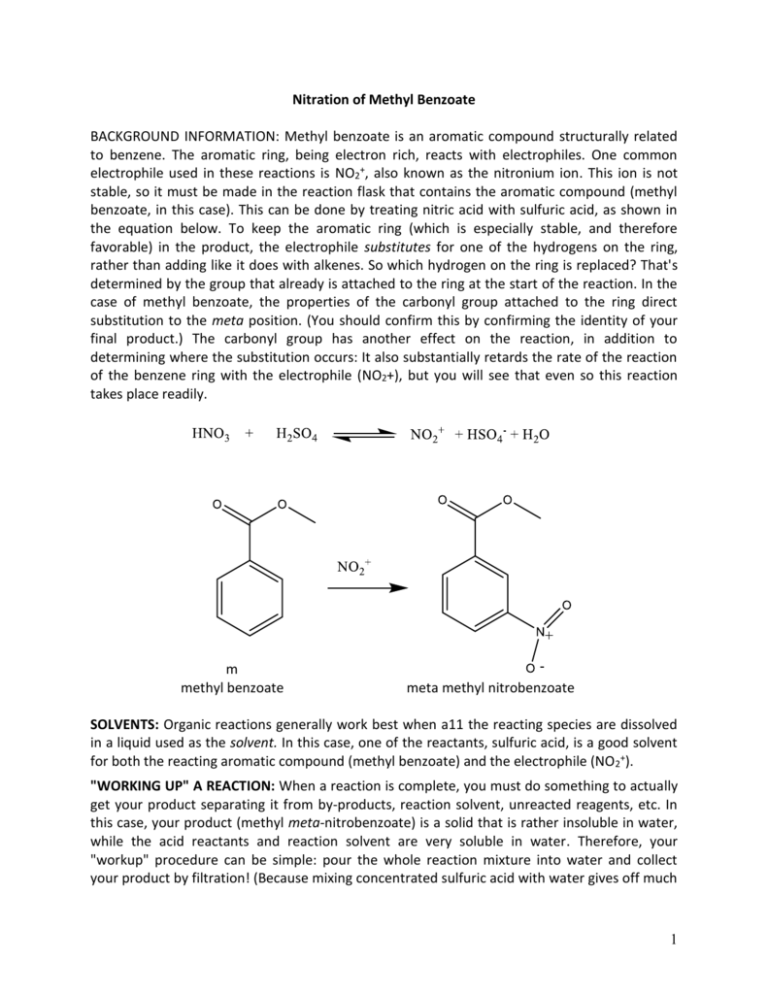
Nitration of Methyl Benzoate BACKGROUND INFORMATION: Methyl benzoate is an aromatic compound structurally related to benzene. The aromatic ring, being electron rich, reacts with electrophiles. One common electrophile used in these reactions is NO2+, also known as the nitronium ion. This ion is not stable, so it must be made in the reaction flask that contains the aromatic compound (methyl benzoate, in this case). This can be done by treating nitric acid with sulfuric acid, as shown in the equation below. To keep the aromatic ring (which is especially stable, and therefore favorable) in the product, the electrophile substitutes for one of the hydrogens on the ring, rather than adding like it does with alkenes. So which hydrogen on the ring is replaced? That's determined by the group that already is attached to the ring at the start of the reaction. In the case of methyl benzoate, the properties of the carbonyl group attached to the ring direct substitution to the meta position. (You should confirm this by confirming the identity of your final product.) The carbonyl group has another effect on the reaction, in addition to determining where the substitution occurs: It also substantially retards the rate of the reaction of the benzene ring with the electrophile (NO2+), but you will see that even so this reaction takes place readily. m methyl benzoate meta methyl nitrobenzoate SOLVENTS: Organic reactions generally work best when a11 the reacting species are dissolved in a liquid used as the solvent. In this case, one of the reactants, sulfuric acid, is a good solvent for both the reacting aromatic compound (methyl benzoate) and the electrophile (NO 2+). "WORKING UP" A REACTION: When a reaction is complete, you must do something to actually get your product separating it from by-products, reaction solvent, unreacted reagents, etc. In this case, your product (methyl meta-nitrobenzoate) is a solid that is rather insoluble in water, while the acid reactants and reaction solvent are very soluble in water. Therefore, your "workup" procedure can be simple: pour the whole reaction mixture into water and collect your product by filtration! (Because mixing concentrated sulfuric acid with water gives off much 1 heat, you actually use ice, rather than water. Once the ice has completely melted, you can finish the work-up.) PURIFYING THE PRODUCT: Typically, products obtained from chemical reactions are not completely pure. There may be unreacted starting material (methyl benzoate, in this case), byproducts (minor amounts of substitution at other places on the ring or at more than one place of the ring, etc.), or other impurities present. Therefore, to obtain the desired product, a purification step often is necessary. In this case, because the product is a solid, it can be purified by recrystallization. Safety Notes! Sulfuric acid and nitric acid are extremely corrosive and can cause severe burns. Nitric acid is a strong oxidizing agent. Use great care to avoid contact with skin, eyes, and clothing. Wear rubber gloves! In case of accidental contact, flood the affected area with copious amounts of water and seek medical attention. Methanol is toxic and must be used in well-ventilated space only. All materials must be discarded in the containers provided Procedure: Place 3 mL of concentrated sulfuric acid in a 25 mL Erlenmeyer flask and cool it in an ice/salt bath (ice + NaCl will bring down the temp to ~ -50C, you will need to add at least 5 g of NaCl to your beaker containing ice and mix with stirring rod, You will need to replace this mixture if you see ice melting as time proceeds!). To the cooled sulfuric acid, slowly add 3 mL of cooled concentrated nitric (cooled in the same ice/salt bath) acid while mixing and cooling (This addition should be slow so that the temperature of the nitrating mixture does not exceed 5 0C!). Cool the resulting nitration mixture in the ice/salt bath until you use it. Place 5 mL of methanol in a test tube and allow it to chill in the same ice/salt bath until you need it for washing your crude product, as described below. Place 2.5 g (within 0.05 g -- record the actual weight) of methyl benzoate in a 50 mL Erlenmeyer flask and cool in an ice/salt bath. Slowly add 3.0 mL of cold (chilled in same ice/salt bath in a 50 mL Erlenmeyer flask) concentrated sulfuric acid with mixing. (Swirl to mix.) Cool the resulting mixture in to below 0°C in an ice/salt bath and add dropwise, the 6 mL of your nitric acid/sulfuric acid mixture (nitrating mixture) over a period of a 10 minutes, keeping the temp at or below 0°C, while swirling the flask in the ice bath/salt to keep the reaction mixture close to 0°C. After the addition is complete, allow the resulting mixture to stand at room temperature for 15 minutes, swirling occasionally. Pour the reaction mixture over 25 g of crushed ice in a 100 or 150 mL beaker, stirring as you pour. Allow any remaining ice to melt and the mixture to stand until crystallization is complete. Collect the crystals by vacuum filtration. To remove the strong acid impurities, do the following: Stop the vacuum, add 10 mL of cooled DI water, stir the product and wash water in the filter funnel (carefully avoiding disturbing the filter paper), and remove the water by turning on the vacuum. Repeat this wash procedure twice (three washes in total). For the third wash, test the 2 pH of the wash water using pH paper. Continue washing, if necessary, until the pH of the wash water is near neutral (pH 5 or above). Then, wash your crystals once using 5 mL of ice-cold methanol. Dry the crude product by using the vacuum to pull air through it for 2-3 minutes, and then weigh your product. Recrystallize your crude product from methanol. (Review the general procedure you used to purify your unknown in experiment 1 before you come to lab!) The amount of hot methanol you use to dissolve your crude product will depend on how much crude product you have. Use a minimum amount, to permit you to obtain the maximum yield when you chill the solution to form purified crystals. You may find that you can skip adding decolorizing carbon and the hot filtration step. Once recrystallization is complete, collect the crystals by vacuum filtration, wash them once with a small amount of cold methanol, dry by pulling air through them, and carefully scrape them from the filter paper for weighing. Record the weight of the purified product and determine its melting point. Confirm the identity of your product by taking a mixed melting point using a sample of known structure. Calculate the % yield of your reaction. Clean up Discard your product, all solid wastes (filter paper, etc.) and liquid wastes in the appropriately labeled containers found in the dispense hood. No organic materials from this experiment go down the drain in the sink! After you have poured all you can into the waste containers, wash glassware containing only residual amounts of acid (clinging to the sides of the glassware) in the sink, taking great care to keep any splattering confined to the sink and using copious amounts of water. Post-Lab Questions: 1. You chill your reaction in an ice bath when adding nitric acid to sulfuric acid. Why? 2. You chill your reaction in an ice bath when adding sulfuric acid to methyl benzoate. Why? 3
